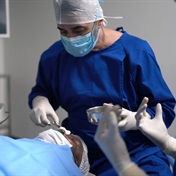Blind patients fitted with a retinal prosthesis system are able to accurately detect motion, according to a new report in the Archives of Ophthalmology.
For 15 of 28 patients with blindness due to retinitis pigmentosa, the Argus II device (Second Sight Medical Products; Sylmar, California) significantly improved their ability to identify the direction of a high-contrast moving bar on a computer screen.
"The subjects can use their arrays to determine the spatial information in a scene," said Dr Jessy D Dorn, research manager at Second Sight and first author of the new study.
While diseases like retinitis pigmentosa and age-related macular degeneration erode vision by destroying photoreceptors, Dr Dorn and her team note, inner retinal cells remain functional in these patients, and electrical stimulation of these cells with implanted electrodes "provides some rudimentary vision."
The Argus II consists of an epiretinal implant containing 60 independently controlled electrodes, an external video processing unit, and a pair of glasses fitted with a miniature video camera. Data and power are relayed wirelessly between the implant and extraocular driver circuitry. The video camera records the scene in front of the user, which is then digitised and filtered to create a 60 pixel-image that is mapped to the corresponding electrodes.
The current study consisted of two experiments. In the first, the researchers tested whether patients could detect the direction of motion better with the device switched on, or with it off. Fifteen patients fared better with the prosthesis on, two performed better with it off, and there was no difference in performance for the remaining 11 patients.
Attain spatial information
The researchers then conducted a follow-up experiment with 11 of the 15 subjects who performed better with the device. Study participants performed the same task of reporting the direction of travel of a high-contrast moving bar on a computer screen. As a control, the researchers scrambled the image-to-electrode mapping, so each pixel would be mapped to a random electrode.
Ten of the 11 patients fared significantly better with the normal spatial mapping, while one patient had no difference in performance between the normal and scrambled conditions.
Some critics have questioned whether patients with retinal implants simply use them to detect light, Dr Dorn noted. "This showed that they can actually do more than that, they can actually get spatial information about what they see in front of them."
The Argus II is currently being sold in Europe, and the US Food and Drug Administration is reviewing an application for marketing the device, Dr Dorn said. The device costs around $100 000, she added, but the company is working with insurers on a case-by-case basis to bring down the actual expense to patients.
The current study was funded by a National Institutes of Health grant to the study's principal investigator, Dr Robert J Greenberg of Second Sight Medical Products, and sponsored by the company. While Second Sight participated in the design of the study, data collection, and manuscript preparation, the study authors state, "Data were collected at each clinical trial site under the supervision of independent site investigators, whose financial interests were limited to compensation for study costs provided to their institutions."
(Reuters Health, October 2012)
Read More:




 Publications
Publications
 Partners
Partners














